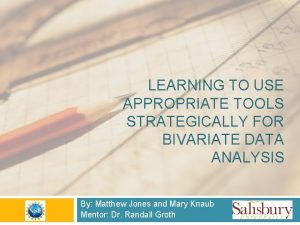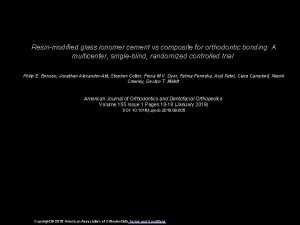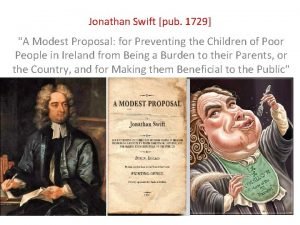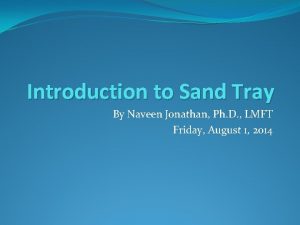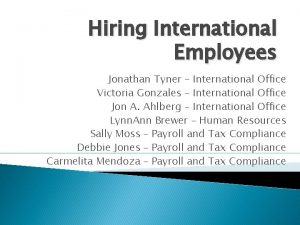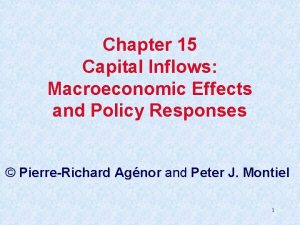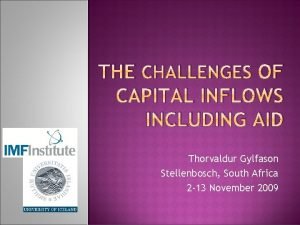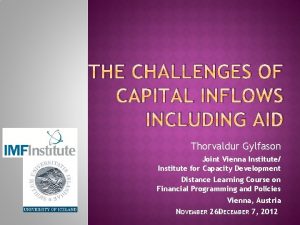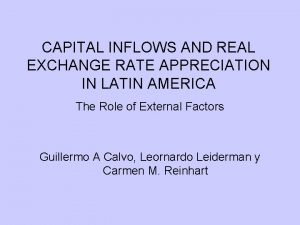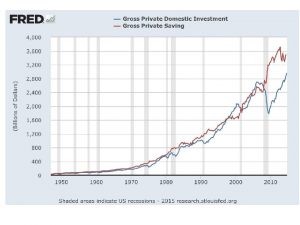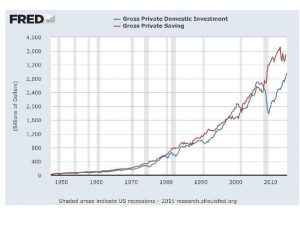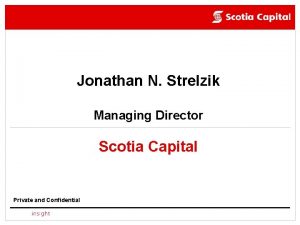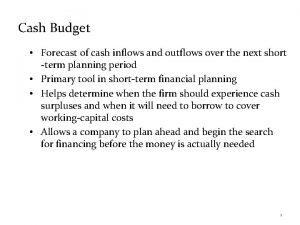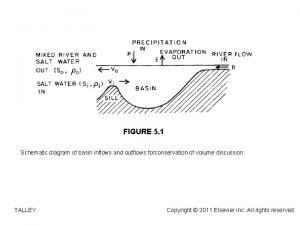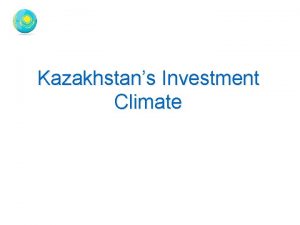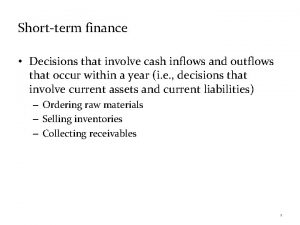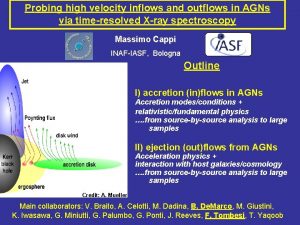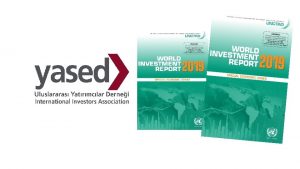MANAGING CAPITAL INFLOWS WHAT TOOLS TO USE Jonathan









































- Slides: 41

MANAGING CAPITAL INFLOWS: WHAT TOOLS TO USE? Jonathan D. Ostry* Research Department, IMF United Nations Conference on Capital Flows Rio De Janeiro August 23, 2011 *The views expressed in this presentation are those of the presenter and do not necessarily represent those of the IMF or IMF policy. This presentation draws on joint work with Atish Ghosh, Karl Habermeier, Luc Laeven, Marcos Chamon, Mahvash Qureshi, and Annamaria Kokenyne.

The advocacy of a control of capital movements must not be taken to mean that the era of international investment should be brought to an end. On the contrary, the system contemplated should greatly facilitate the restoration of international loans and credits for legitimate purposes. JOHN MAYNARD KEYNES There is a tendency to regard foreign exchange controls, or any interference with the free movement of funds as, ipso facto, bad. . . [but] there are times when it is in the best economic interest of a country to impose restrictions on movements of capital…[and] there are periods when failure to impose controls…have led to serious economic disruption. The task before us is not to prohibit instruments of control but to develop those measures of control, those policies of administering such control, as will be the most effective in obtaining the objectives of world-wide sustained prosperity HARRY DEXTER WHITE

Capital Controls: Not Just An EME Phenomenon Capital Account Restrictiveness in Selected Advanced Economies 1960 -2006 Capital Account Restrictiveness in Advanced Economies: Some Examples 1960 -2006 1. 0 0. 8 0. 6 0. 4 0. 2 0. 0 1960 -1969 1970 -1979 Canada 1980 -1989 France Germany 1990 -1999 UK US Note: Capital account restrictiveness index (0=highly restrictive; 1=fully liberalized). Source: Quinn and Toyoda (2008). 2000 -2006 0. 0 Canada: Interest payments on inward financial credits, and inter -bank loans and deposits subject to a withholding tax France: "Devise-titre” system: residents could only reinvest the proceeds of sales of previously held foreign securities; could not increase their foreign asset holdings 1960 1965 Canada 1970 France 1975 1980 Germany: Ban on non-resident purchases of German bonds introduced in 1972 (and lifted in 1974). Discriminatory reserve requirements employed UK: Purchases of foreign securities by UK residents required foreign exchange bought at a premium USA: Interest Equalization Tax (IET) on purchases of foreign, fixed interest securities; tax was abandoned in 1974 soon after the adoption of floating exchange rates 1985 1990 1995 United Kingdom 2000 2005 United States Note: Capital account restrictiveness index (0=highly restrictive; 1=fully liberalized). Source: Quinn and Toyoda (2008), and OECD (1982). 2

Context 3 3

Capital Inflows: Recovery or Historic Surge? Net Quarterly Capital Flows into EMEs, 2006 Q 1 -11 Q 1 (billions of US dollars) Net Annual Capital Flows into EMEs, 2001 -2016 (billions of US dollars) 4

Strong Fundamentals in EMEs Annual Real GDP Growth (in percent) Source: IMF’s WEO database. Note: Average year-on-year growth (in percent). Public Debt to GDP (in percent) Source: IMF’s WEO database. Note: Average gross general government debt to GDP ratio (in percent). 5

The Search for Yield… Interest Rate Differential (in basis points) 1300 Brazil Returns on Assets (in percent) Gold 136, 4 GBI-EM Global div 1100 900 54, 6 US High Grade South Africa Mexico 700 42, 5 US High Yield 40, 2 EMBIG 40, 0 CEMBI Broad 500 36, 0 Korea ELMI+ 300 China ян мав-0 7 мар-0 7 июй-0 л- 7 се 0 7 нон-0 7 я ян -0 7 мав-0 8 мар-0 8 июй-0 л- 8 се 08 нон-0 8 яня-0 8 мав-0 9 мар-0 9 й ию -0 л- 9 се 09 нон-0 9 яня-0 9 мав-1 0 мар-1 0 й ию -1 л- 0 се 10 нон-1 0 яня-1 0 мав-1 1 мар-1 й- 1 11 100 -100 EM equities Commodities UST 30, 1 10, 2 9, 9 1, 7 S&P -10, 5 500 -300 Source: Bloomberg. Note: 10 -year government bond yield minus 3 -month US T-bill rate in basis points. Source: J. P. Morgan. Note: Returns as of June 29, 2007 to May 31, 2011 (in percent). 6

Improved Sovereign Credit Ratings Sovereign Rating Upgrades & Downgrades EMBI Global Average Credit Rating Developed Up Developed Down Emerging Up Emerging Down 35 28 28 28 19 14 14 12 11 10 7 6 5 1 0 0 2007 Source: Chang (2011). Note: EM fixed income indices are now investment grade. (> BBB-). 4 0 2008 0 2009 0 2011 YTD Source: Chang (2011). Note: the total number of upgrades and downgrades includes both S&P and Moody’s actions. Last developed market sovereign rating upgrade occurred in 2007. 7

Is it Push or Pull Factors? Large literature on determinants of capital flows to EMEs identifies: Push factors—Interest rate in advanced economies, commodity prices, investor risk appetite, regional contagion Pull factors—Macroeconomic performance, trade and financial openness, institutional quality, external vulnerability Ghosh et al. (2011) examine inflow surges to EMEs over 1980 -2009 Surges are highly synchronized across regions; but Considerable heterogeneity in the amount of inflow in a surge Both push and pull factors matter—but in different ways For surge occurrence, push factors matter (notably, the real US interest rate; international market uncertainty) For surge magnitude, domestic conditions are important (e. g. macroeconomic 8 performance, trade & financial openness, exchange rate flexibility)

Inflation and Credit Growth: Selected Cases 9

Are New Bubbles Emerging in EMs? Real House Prices Note: Non-weighted averages of the real house price index. 2007 Q 3 is set to equal 100. Source: OECD, Global Property Data, Haver Analytics and national sources. Real Credit to the Private Sector Note: Non-weighted averages of the annual growth of real private credit. (in percent). The group of “other emerging economies” lies below the 75 th percentile of the distribution of the 2010 Q 1 -2010 Q 4 average of the annual growth of real domestic credit to the private sector. 10 Source: IMF IFS.

Policy Responses to Capital Inflows 11

Capital Controls, Macroeconomic and Prudential Risks 12

When are Capital Controls Appropriate? IMF staff (Ostry et al. , Feb. 2010) argued that capital controls appropriate for inclusion in the policy toolkit to address: Macroeconomic risks, when Currency overvalued Further reserve accumulation undesirable Inflation/overheating concerns Limited scope for fiscal tightening Financial-stability risks, when Prudential framework still leaves high risk of financial fragility 13

Key Questions to be Addressed Ostry et al. (2011) examine: How macroeconomic and prudential rationales for capital controls fit together? What are the main elements of the policy toolkit (once macro-policy space is exhausted)? What combination of prudential measures and controls should be deployed to address inflow-induced risks? How should capital controls be designed? 14

How do Macro and Prudential Concerns Fit Together? Capital inflow surge Macroeconomic concerns Financial-stability risks Primary responses Macro policies: exchange rate appreciation, reserves accumulation, fiscal and monetary policy mix Prudential policies: Strengthen/introduce prudential measures Macro policy options exhausted? Residual risks? Impose/intensify capital controls (or measures that act like them) subject to multilateral considerations and macro tests 15

How do Macro and Prudential Concerns Fit Together? Both macroeconomic and prudential considerations suggest that capital controls are appropriate No real conflict—but possible design issues Macro considerations say yes, but prudential ones say no No conflict of principle, but again possible conflict of design Controls as transitional measure given macro policy implementation lags? Macro considerations say no, prudential ones say yes Genuine conflict Multilaterally-consistent approach implies the bar is much higher for the use of capital controls—especially broad-based controls Exhaust the available macro policy space and allow exchange rate appreciation before tightening capital controls on inflows for prudential risks 16

The Policy Toolkit 17

What’s in the Toolbox? FX-related prudential measures Discriminate according to the currency, not the residency, of the flow Applied to regulated financial institutions, primarily banks Examples: limits on banks’ open FX position (as a proportion of their capital), and limits on FX lending by domestic banks (or higher capital requirements) Other prudential measures Reduce systemic risk without discriminating based on residency/currency Examples: LTV ratios, limits on credit growth and sectoral lending, dynamic loanloss provisions, and counter-cyclical capital requirements Capital controls Discriminate between residents and non-residents in cross-border capital movements (OECD Code of Liberalization of Capital Movements, 2009) Economy-wide or sector specific (usually the financial sector) or industry specific Cover all flows, or target specific types (debt, equity, FDI; short vs. long-term) Examples: taxes, URRs, licensing requirements, and outright limits or bans 18

How Common are the Measures? 19

Recent Examples of Measures FX-related measures Other prudential measures Capital controls • Reserve requirements on foreign currency deposits (Peru) • Limits on banks FX derivative positions in percent of bank capital (Korea) • Capital requirements for FX loans (Peru) • Limits on banks net open FX positions (Peru) • Limits on ratio of banks FX loans and securities to FX borrowing (Korea) • • Reserve requirements for local currency deposits (Brazil, Turkey) LTV ratios (Korea, Peru, Thailand, Turkey) Levy on interest from consumer loans (Turkey) Capital requirements for specific loans (Brazil) • Tax on equity and bond inflows (Brazil) • Fee on NR purchases of central bank paper (Peru) • Reserve requirements on NR deposits (Peru) 20

Issues in Classifying Instruments De jure prudential tools may operate like capital controls A regulation differentiating based on the currency of denomination may operate like a capital control to the degree that most FX liabilities are to nonresidents A measure that requires banks to pay a tax on their non-core liabilities could well in practice operate just like a capital control if most of the funding that banks receive comes from abroad A regulation discouraging FX lending to unhedged borrowers may act as a capital control (reduce inflow) or prudential measure (change currency composition of foreign liabilities). Difficult to tell at implementation stage De jure capital controls may have primarily prudential intent (e. g. differential reserve requirements by residence of liability) Fine line between FX-related and other prudential measures (e. g. differential LTV ratio by currency of denomination) 21

Alternative Classification Capital Flow Management Measures (CFMs)—measures designed to influence capital flows Residency-based—commonly referred to as capital controls Other—measures that do not discriminate on the basis of residency, but are nonetheless designed to influence capital inflows (including a subset of prudential measures that discriminate on the basis of currency) Non-CFMs—structural and prudential policies not designed to influence capital flows. Include measures that do not discriminate by residency and typically, but not always, do not differentiate by currency 22

Matching Risks and Tools 23 23

Choice of Instruments: Flows Intermediated through the Financial Sector Flows to domestic banks Fragile external liability structure (maturity mismatch/sudden-stop risk) Currency risk (due to open FX position) or credit risk (due to unhedged borrower) Credit boom/asset price bubble FX-related prudential 1/ Other prudential Ceilings on banks’ foreign derivative positions/Capital controls on banks (esp. short-term debt), e. g. , taxes/reserve requirements Open FX limits/higher capital requirements on loans to unhedged borrowers Cyclical capital requirements, LTV limits Legal or other impediments to capital controls? Concerns about access to finance/ distortions? FX-related prudential Capital controls FX-related prudential/ Capital controls 1/ 1/ Once macro policy space exhausted, and taking due account of multilateral considerations. 24

Choice of Instruments: Flows Not Intermediated through the Financial Sector Direct flows or through unregulated financial sector Fragile external liability structure (debt, especially short-term) Currency risk (due to lack of natural or financial hedge) Asset price bubble Capital controls 1/ Capital controls to discourage debt instruments Capital controls to discourage FX borrowing by unhedged entities Broad-based capital controls Legal or other impediments to capital controls? Borrower-based FX-measures 25 1/ Once macro policy space exhausted, and taking due account of multilateral considerations

Exceptions to Flow Chart § Playing field for access to credit of large firms vs. SMEs § Prudential regulations may cause flows to be intermediated through the unregulated financial sector (e. g. Croatia) - Extend the perimeter of regulation? Not easy in short run - Regulatory arbitrage more likely in countries with weak supervision, sophisticated financial institutions, and deep capital markets § International obligations may prohibit or constrain the use of capital controls (e. g. , the EU treaty, the GATS, the OECD code, or various bilateral investment treaties) 26

Policy Measures and Financial Stability Risks: Some Suggestive Evidence 27

Empirical Evidence: External Liability Structure Debt in proportion to total external liabilities Cross section (2007; measures in 2003 -05, 38 countries) Economy-wide, and financial sector capital controls significantly associated with lower debt (controlling for external vulnerability) FX regulations significantly associated with lower debt (though FX regulations lose significance when included together with economy-wide capital controls) Moving from 25 th to 75 th percentile of economy-wide capital controls or FXregulation lowers debt share by almost 10 ppt Panel data (1995 -2008) Economy-wide, and financial sector capital controls significantly associated with lower debt External vulnerability index, region and time effects, and per capita income 28 included as additional regressors

External Liability Structure: Cross-Sectional Evidence* Debt Liabilities Capital controls and FX-related prudential measures associated with smaller proportion of debt in external liabilities … Source: Authors’ estimates. *Sample: 38 EMEs over 2003 -07. Debt liabilities is the residual (including constant) obtained after regressing the share of debt liabilities in total external liabilities in 2007 (in percent) on a (lagged) composite external vulnerability index. 29

Empirical Evidence: FX Lending Foreign currency loans in total domestic credit Cross section (2007; measures in 2003 -05, 28 countries) Economy-wide, and financial sector capital controls significantly associated with lower proportion of FX credit (controls: initial private credit ratio; exchange rate regime) FX regulations significantly associated with lower FX credit Both economy-wide capital controls and FX regulations significant when included together Moving from 25 th to 75 th percentile of economy-wide capital controls and FX regulations lowers proportion of FX credit by 20 -25 ppt Panel data (1995 -2008) Results similar to those above Private credit (lagged, in % of GDP); exchange rate regime; per capita income; institutional quality index; region and time dummies included as additional regressors 30

FX Lending: Cross-Sectional Evidence* Capital controls and FX-related prudential measures associated with lower foreign currency denominated lending by domestic banks Source: Authors’ estimates. *Sample: 28 EMEs over 2003 -07. Forex credit is the residual (including constant) obtained after regressing forex credit to GDP in 2007 on private credit to GDP in 2005 and a binary variable (=1) if fixed exchange rate regime in place. 31

Empirical Evidence: Credit Booms Change in private sector credit to GDP ratio Cross section (change in credit ratio 2003 -07; measures in 2000 -02, 28 countries) Prudential regulations significantly associated with smaller credit booms (controls: real per capita income in 2005; political stability index; financial market development; exchange rate regime; and credit bureaus) Prudential regulations significant if capital controls/FX regulations included Moving from 25 th to 75 th percentile of prudential regulations lowers credit growth (03 -07) by 1. 5 percent per year Panel data (1995 -2008) Results similar to those above Region and time dummies, per capita income, political stability index, stock market capitalization, exchange rate regime and credit bureaus included as 32 additional regressors

Credit Booms: Cross-Sectional Evidence* Other prudential measures associated with lower lending booms by domestic banks Source: Authors’ estimates. *Sample: 28 EMEs over 2003 -07. Private credit boom is the residual (including constant) obtained after regressing change in private credit to GDP over 2003 -07 on private credit to GDP in 2003. 33

Empirical Evidence: Crisis Resilience If policy measures reduce vulnerabilities through previous channels, then downturn in event of crisis should be smaller Cross-section (change in growth 2008 -09 relative to average 2003 -07, 41 countries) Economy-wide capital controls, FX and domestic prudential regulations associated with smaller decline (controlling for growth in trading partners, change in terms of trade) Both economy-wide capital controls and domestic prudential regulations retain significance when included together But economy-wide capital controls dominate when included with FX regulations Moving from 25 th to 75 th percentile of economy-wide controls or FX regulations lowers growth decline by 3. 5 and 2. 5 ppt, respectively Past Crises(1995 -2008) Capital controls associated with smaller growth decline in past crises 34

Crisis Resilience: Recent Crisis* Capital controls, FX-related and other prudential measures associated with greater crisis resilience Source: Authors’ estimates. *Sample: 41 EMEs over 2003 -07. Crisis resilience is the residual (including constant) obtained after regressing the difference between real GDP growth rates averaged over 2008 -09 and 2003 -07 on trading partner growth and terms of trade change. 35

Robustness Numerous robustness tests Additional regressors to capture political stability, financial market development, and overall regulatory quality Alternative indices (use first principal component of subindices instead of averages) Endogeneity—use bilateral investment treaty with US (which generally prohibit use of capital controls) as instrument for capital control Key results are unaffected or strengthened 36

Designing Capital Control Instruments 37

Designing Capital Controls: Some Considerations § Broad principles § Effective: achieve intended aim; not easily circumvented § Efficient: minimize distortions and scope for non-transparent/arbitrary enforcement § But a number of questions… § Permanent or temporary inflow? − Macroeconomic concerns: Controls for temporary, not permanent inflows − Prudential concerns: Controls could be imposed for persistent flows § Broad-based or targeted controls? − Macroeconomic concerns: Broad based possibly with limited exemptions − Prudential concerns: Targeted but taking account of circumvention possibilities § Price or quantity-based controls? − Macro concerns: Price-based measures easier to adjust cyclically, and simpler to administer − Prudential concerns: Quantitative measures more appropriate when authorities face information asymmetries/uncertainty about private sector’s response § Other considerations: Administrative and institutional capacity 38

Conclusions 39

Key Takeaways Macro and prudential policies can go a long way to deal with inflow surges There is strength in numbers—no measure is likely to work perfectly, so diversify and use more than one Capital controls and prudential measures should target specific risks Use and strengthen orthodox toolkit before resorting to capital controls Prudential measures main instrument when flows are intermediated through the banking sector Capital controls main instrument when flows by-pass the banking sector In designing capital controls, Macro concerns imply broad and price-based controls for temporary surges Prudential concerns imply targeted on specific risks and possibly administrative capital-control measures, even in case of persistent inflows Design should reflect administrative inheritance/apparatus 40
 Fixed capital and working capital
Fixed capital and working capital Source of capital reserve
Source of capital reserve Multinational capital structure
Multinational capital structure Difference between capital reserve and reserve capital
Difference between capital reserve and reserve capital Regulatory capital vs economic capital
Regulatory capital vs economic capital Regulatory capital vs economic capital
Regulatory capital vs economic capital Variable capital examples
Variable capital examples Multinational cost of capital and capital structure
Multinational cost of capital and capital structure Capital allocation line vs capital market line
Capital allocation line vs capital market line Cutting tools in sewing with pictures and meaning
Cutting tools in sewing with pictures and meaning Capital after question mark
Capital after question mark Tools use in sewing
Tools use in sewing Ms paint pencil tool
Ms paint pencil tool Common business tools and technology
Common business tools and technology Use appropriate tools strategically
Use appropriate tools strategically What tools did the neolithic use
What tools did the neolithic use Use developer tools to create custom visuals power bi
Use developer tools to create custom visuals power bi What tools did the greeks use in geometric constructions
What tools did the greeks use in geometric constructions How you use ict today and how you will use it tomorrow
How you use ict today and how you will use it tomorrow Jonathan borden md
Jonathan borden md Frances and jonathan eduqas
Frances and jonathan eduqas Dr jonathan kushner
Dr jonathan kushner Jonathan eluterio martinez garcia
Jonathan eluterio martinez garcia Jonathan smart ofsted
Jonathan smart ofsted Jonathan markow
Jonathan markow Jonathan lebed
Jonathan lebed Il gabbiano jonathan livingston attività didattiche
Il gabbiano jonathan livingston attività didattiche Galeb jonathan livingston stilske figure
Galeb jonathan livingston stilske figure Frances meek
Frances meek Jonathan alexander abt
Jonathan alexander abt Joni rutter
Joni rutter Karen schwindt
Karen schwindt Jonathan swift 1729
Jonathan swift 1729 Jonathan swift epitaph
Jonathan swift epitaph Jonathan earl franzen
Jonathan earl franzen Jonathan edwards triple jumper
Jonathan edwards triple jumper Jake cashion
Jake cashion Naveen ashish
Naveen ashish Jonathan slocum
Jonathan slocum Jonathan nussbaumer
Jonathan nussbaumer Jonathan tyner texas state university
Jonathan tyner texas state university Jonathan dsouza
Jonathan dsouza














